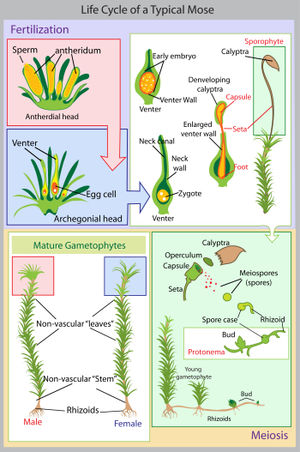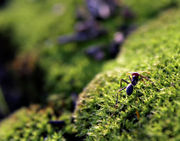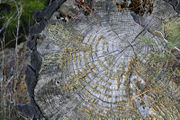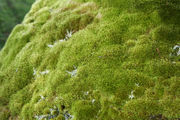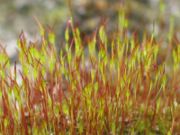Moss
2007 Schools Wikipedia Selection. Related subjects: Plants
| iMoss | ||||||
|---|---|---|---|---|---|---|
 "Muscinae" from Ernst Haeckel's Kunstformen der Natur, 1904
|
||||||
| Scientific classification | ||||||
|
||||||
|
|
||||||
|
Mosses are small, soft plants that are typically 1-10 cm tall, occasionally more. They commonly grow close together in clumps or mats in damp or shady locations. They do not have flowers or seeds, and their simple leaves cover the thin wiry stems. At certain times mosses produces spore capsules which may appear as beak-like capsules borne aloft on thin stalks.
Life cycle
Most kinds of plants have a double portion of chromosomes in their cells ( diploid, i.e. each chromosome exists with a partner that contains the same genetic information) whilst mosses (and other bryophytes) have only a single set of chromosomes ( haploid, i.e. each chromosome exists in a unique copy within the cell). There are periods in the moss lifecycle when they do have a full, paired set of chromosomes but this is only during the sporophyte stage.
The life of a moss starts from a haploid spore, which germinates to produce a protonema, which is either a mass of filaments or thalloid (flat and thallus-like). This is a transitory stage in the life of a moss. From the protonema grows the gametophore ("gamete-bearer") that is differentiated into stems and leaves ('microphylls'). From the tips of stems or branches develop the sex organs of the mosses. The female organs are known as archegonia (sing. archegonium) and are protected by a group of modified leaves known as the perichaetum (plural, perichaeta). The archegonia have necks called venters which the male sperm swim down. The male organs are known as antheridia (singular antheridium) and are enclosed by modified leaves called the perigonium (plural, perigonia).
Mosses can be either dioicous (compare with dioecious in seed plants) or monoicous (compare monoecious). In dioicous mosses, both male and female sex organs are borne on different gametophyte plants. In monoicous (also called autoicous) mosses, they are borne on the same plant. In the presence of water, sperm from the antheridia swim to the archegonia and fertilisation occurs, leading to the production of a diploid sporophyte. The sperm of mosses is biflagellate, i.e. they have two flagella that aid in propulsion. Without water, fertilisation cannot occur. After fertilisation, the immature sporophyte pushes its way out of the archegonial venter. It takes about a quarter to half a year for the sporophyte to mature. The sporophyte body comprises a long stalk, called a seta, and a capsule capped by a cap called the operculum. The capsule and operculum are in turn sheathed by a haploid calyptra which is the remains of the archegonial venter. The calyptra usually falls off when the capsule is mature. Within the capsule, spore-producing cells undergo meiosis to form haploid spores, upon which the cycle can start again. The mouth of the capsule is usually ringed by a set of teeth called peristome. This may be absent in some mosses.
In some mosses, green vegetative structures called gemmae are produced on leaves or branches, which can break off and form new plants without the need to go through the cycle of fertilisation. This is a means of asexual reproduction.
Classification of mosses
Mosses were traditionally grouped with the liverworts and hornworts in the Division Bryophyta ( bryophytes), within which the mosses made up the class Musci. This group, however, is paraphyletic and now tends to be split up. In such system, the Division Bryophyta refers specifically to mosses. They appear to be the closest living relatives of the vascular plants.
The mosses are grouped as a single class, now named Bryopsida, and divided into seven subclasses:
- Andreaeidae
- Sphagnidae
- Tetraphidae
- Polytrichidae
- Buxbaumiidae
- Bryidae
- Archidiidae
Andreaeidae are distinguished by the biseriate (two rows of cells) rhizoids, multiseriate (many rows of cells) protonema, and sporangium that splits along longitudinal lines. Most mosses have capsules that open at the top.
The Sphagnidae, the peat-mosses, comprise the single genus Sphagnum. These large mosses form extensive acidic bogs in peat swamps. The leaves of Sphagnum have large dead cells alternating with living photosynthetic cells. The dead cells help to store water. Aside from this character, the unique branching, thallose (flat and expanded) protonema, and explosively rupturing sporangium place it apart from other mosses.
The Tetraphidae are unique (as their name implies) in having only four large peristome teeth surrounding the opening of the capsule.
Polytrichidae have leaves with lamellae, which are flaps on the leaves that look like the fins on a heat sink. These help it retain moisture. They differ from other mosses in other details of their development and anatomy too, and can also become larger than most other mosses, with e.g. Polytrichum commune forming cushions up to 40 cm high.
The Buxbaumiidae are called 'bug mosses' because they usually have a very small and reduced gametophore and the whole plant is mostly the sporophyte capsule. The shape reminds one of a bug, which is the reason for its common name.
The Bryidae are the most diverse group; over 95% of moss species belong to this subclass.
The Archidiidae are distinguished by their extremely large spores and the way the sporangium develops.
Habitat
Mosses are found chiefly in areas of low light and dampness; any area of the world. Mosses are common in wooded areas and at the edges of streams. Mosses are also found in cracks between paving stones in damp city streets. Some types have adapted to urban conditions and are found only in cities. A few species are wholly aquatic, such as Fontinalis antipyretica, and others such as Sphagnum inhabit bogs, marshes and very slow-moving waterways. Such aquatic or semi-aquatic mosses can greatly exceed the normal range of lengths seen in terestial mosses. Individual plants 20-30 cm or more long are common in Sphagnum species for example.
Wherever they occur, mosses require moisture to survive because of the small size and thinness of tissues, lack of cuticle (waxy covering to prevent water loss), and the need for liquid water to complete fertilisation. Some mosses can survive desiccation, returning to life within a few hours of rehydration.
In northern latitudes, the north side of trees and rocks will generally have more moss on average than other sides. This is assumed to be because of the lack of sufficient water for reproduction on the sun-facing side of trees. South of the equator the reverse is true. In deep forests where sunlight does not penetrate, mosses grow equally well on all sides of the tree trunk.
Cultivation
Moss is considered a weed in grass lawns, but is deliberately encouraged to grow under aesthetic principles exemplified by Japanese gardening. In old temple gardens, moss can carpet a forest scene. Moss is thought to add a sense of calm, age, and stillness to a garden scene. Rules of cultivation are not widely established. Moss collections are quite often begun using samples transplanted from the wild in a water-retaining bag. However, specific species of moss can be extremely difficult to maintain away from their natural sites with their unique combinations of light, humidity, shelter from wind, etc.
Growing moss from spores is even less controlled. Moss spores fall in a constant rain on exposed surfaces; those surfaces which are hospitable to a certain species of moss will typically be colonised by that moss within a few years of exposure to wind and rain. Materials which are porous and moisture retentive, such as brick, wood, and certain coarse concrete mixtures are hospitable to moss. Surfaces can also be prepared with acidic substances, including buttermilk, yogurt, urine, and gently puréed mixtures of moss samples, water and ericaceous compost.
Mossery
A passing fad for moss-collecting in the late 19th century led to the establishment of mosseries in many British and American gardens. The mossery is typically constructed out of slatted wood, with a flat roof, open to the north side (maintaining shade). Samples of moss were installed in the cracks between wood slats. The whole mossery would then be regularly moistened to maintain growth.
Commercial use
There is a substantial market in mosses gathered from the wild. The uses for intact moss are principally in the florist trade and for home decoration. Decaying moss in the genus Sphagnum is also the major component of peat, which is "mined" for use as a fuel, as a horticultural soil additive, and in smoking malt in the production of Scotch whisky. There are growing concerns in parts of the world where this trade is growing, that significant environmental damage may be caused by commercial peat harvesting. In World War II, Sphagnum mosses were used as first-aid dressings on soldiers' wounds, as these mosses are highly absorbant and have mild antibacterial properties. Some early people used it as a diaper due to its high absorbency.
In rural UK, Fontinalis antipyretica was traditionally used to extinguish fires as it could be found in substantial quantities in slow-moving rivers and the moss retained large volumes of water which helped extinguish the flames. This historical use is reflected in its specific Latin/ Greek name, the approximate meaning of which is "against fire".
In Finland peat mosses have been used to make bread during famines.
